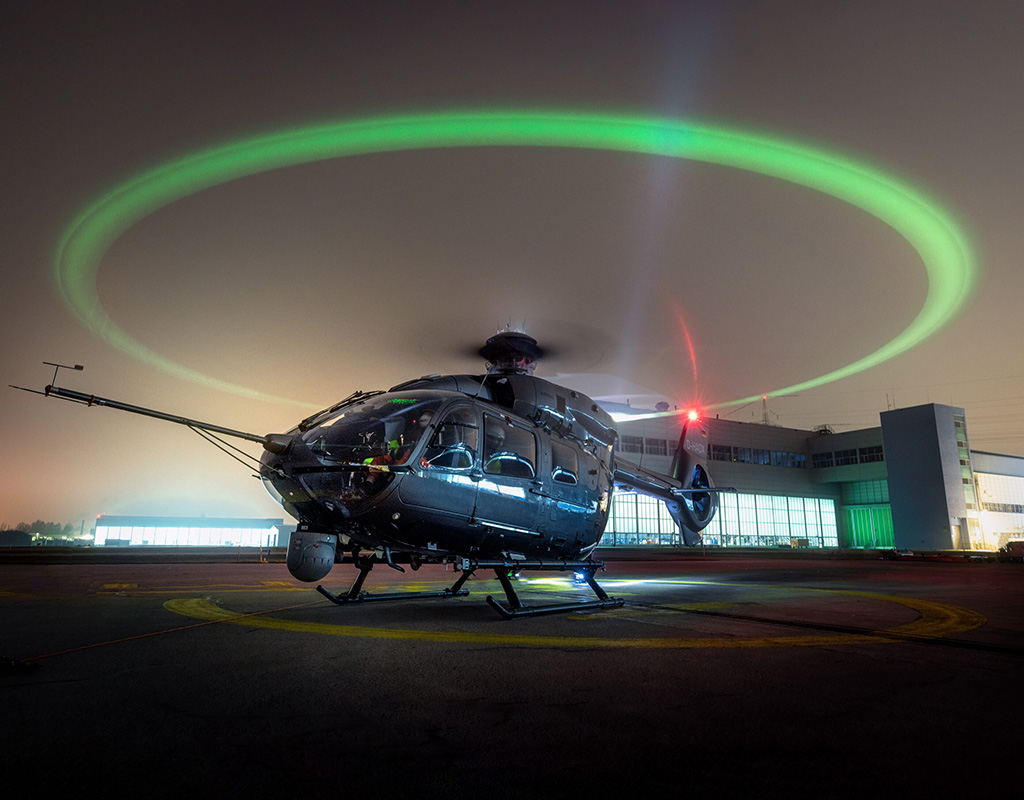
Airbus Helicopters is developing a new Law Enforcement Mission System configuration for its H145 light twin, including a foldable mission operator station, a mission system with artificial intelligence, a next-generation hoist, and illuminated blade tips.
The configuration is to be launched with the Bavarian police force in Germany.
“We have challenged ourselves to bring the best of technology into their new police helicopters, gathering their needs, [and] identifying the possible techniques to enable this,” Axel Humpert, senior vice president and head of H145 program, told reporters during a recent briefing on the type.
The system includes a 17-inch display as part of a mission operator station, which can be installed on either side of the aircraft’s cabin. When not in use, it can be folded and moved out of the way to free up cabin space. The system operator can also work from the left seat in the cockpit, if desired, from another 17-inch display — leaving eight passenger seats available in the cabin.
Data will be able to be downloaded from and uploaded to the aircraft at “a very high speed,” said Humpert.
Meanwhile, the next-generation hoist will provide new safety enhancements while offering an increased load capacity and faster reel in/out time.
The hoist, developed by Vincoriun to Airbus’s specifications, will have a load capacity of 668 pounds (303 kilograms), and be capable of reeling in and out 30 percent fast than current hoists, said Humpert.
“The time we spend in the hover zone or in the danger zone above the sea or a mountainous area is [therefore] reduced,” he said.
The hoist’s development was in response to a request from the European Union Aviation Safety Agency for enhanced hoist safety, said Humpert. One aspect was ensuring that the cable, if cut, could not jump into the aircraft’s rotor blades, while another was the provision of a dual clutch on the system.
He added that Airbus is also focusing on the maintenance aspect of the hoist, with “significantly increased” time between overhaul and reduced direct maintenance costs targeted.
The company has begun installation trials with the hoist and hopes to have it certified by the middle of 2024.
The aircraft’s illuminated blade tips will be compatible with night vision goggles (NVGs), said Humpet, and will serve to enhance situational awareness for pilots when they are flying close to obstacles.
The manufacturer has begun assembly of the first aircraft with the new configuration. Some will be used for police training flights, while one will be kept for qualification and certification of the system. Delivery of the aircraft in full configuration will begin next year.
Upgrades in Development
Other major programs in development for the H145 include a new cockpit video flight data recorder, which includes a tail rotor video/live feed, and a required navigation performance (RPN) system from Garmin for Swiss operator Rega and another customer. The latter will allow precision navigation down to 0.1 nautical miles without the use of GPS satellites, and will enter operation in fall 2024.
The H145 is also expected to receive the next evolution (V10) of Airbus’s in-house Helionix avionics system in the second quarter of 2023. The new version will have a vortex protection system incorporated into the autopilot, said Humpert.
Other upcoming upgrades include an ADS-B In capability with a Lynx transponder, the incorporation of the RDR7000 search-and-rescue radar, and new AFCS modes allowing for assisted takeoffs or landings.
“[The pilot] pre-selects on ground the kind of takeoff he wants to have, then brings the helicopter into hover, pushes the button, and the rest is done automatically by the helicopter,” said Humpert. “It’s either continuing the takeoff, or, in [the] case of engine failure before the takeoff decision point, is bringing the helicopter back to the safe landing, where only in the final phase the pilot has to lower the collective.”
The aim is reduced workload for the pilot, he said.
Finally, Airbus hopes to deliver the first blade folding kit for the H145 “rather soon,” said Humpert. The kit, first announced when Airbus unveiled the five-bladed upgrade to the type in 2019, allows the aircraft’s blades to be folded rearwards towards the aircraft’s tail. The idea is to reduce the H145’s footprint and minimize its storage requirements.
The first kit will be delivered to a customer who will use the aircraft on board a ship.
Airbus recorded 83 orders for the H145 in 2022, which it said represented 43 percent of the global light twin orders in the year. Over 1,600 H145s are now in service with 330 operators in 70 countries, and the global fleet passed the landmark of seven million flight hours in 2022.

